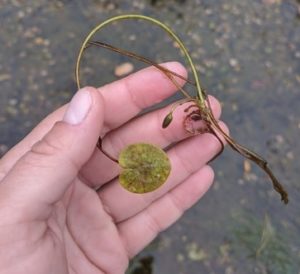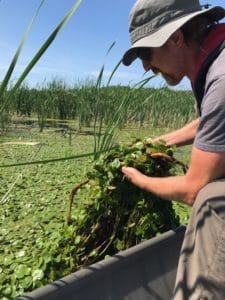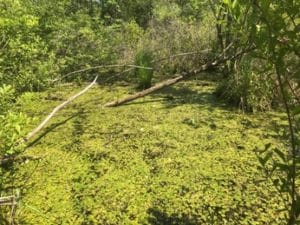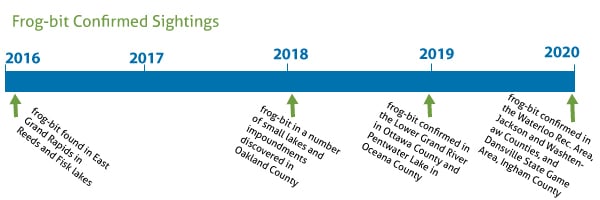If you live on or near the water – including small neighborhood impoundments – or enjoy boating and recreating locally, you should know about this invasive species, which now lives in the Huron River watershed.
Next summer, HRWC will be conducting an extensive monitoring campaign to learn more about the spread of European frog-bit in southeast Michigan. Join our free virtual public meeting on Thursday, December 10 at 7pm to learn how to identify European frog-bit and what you can do to help our monitoring efforts. HRWC is collaborating with the Oakland County Cooperative Invasive Species Management Area (CISMA) and other partners on this session.

What is European frog-bit?
European frog-bit is an aquatic plant that resembles a small lily pad about the size of a quarter. Frog-bit grows in dense, tangled mats of leaves and stems on the surface of slow moving water. It thrives in impoundments, backwaters and bays, where it impedes boaters and other recreationists and alters habitat for water birds and fish.
European frog-bit is a Watch List Species that is prohibited in the State of Michigan, which means that it is illegal to possess, distribute, import, or sell frog-bit in the state (except in unique circumstances).
History of frog-bit in Michigan
European frog-bit was first discovered in southeast Michigan in 1996 and has since been documented in a number of regional counties. Frog-bit has also spread to lake Erie and up the coast to Lake Huron, all the way to the eastern Upper Peninsula.
2020: frog-bit confirmed in the Waterloo Recreation Area in Jackson and Washtenaw Counties and the Dansville State Game Area in Ingham County.
What is happening now

The Department of Environment, Great Lakes and Energy (EGLE) has conducted surveys for frog-bit in a number of regional water bodies including in the Waterloo and Pickney Recreation Areas.
HRWC will be working in collaboration with the Oakland County Cooperative Invasive Species Management Area (CISMA) to monitor lakes, wetlands, impoundments and creeks in our watershed beginning in spring of 2021.
The Oakland County CISMA has begun controlling known frog-bit infestations in some areas. Control can be achieved by pulling all visible frog-bit plants and returning to the treated area the following year to address new plant growth. However, extensive infestations often require more robust control efforts including herbicide application.
What you can do to help
Clean, Drain and Dry
As with other aquatic invasive species, it is important for boaters, anglers, water fowl hunters and other recreationists to follow the “Clean, Drain and Dry” rules for boats, trailers, vehicles and equipment before moving from one water body to another. State law requires that you drain all water from bilges, live wells and ballast tanks, and remove all aquatic organisms from your boat, motor, trailers and other equipment. Learn more about invasive species here.
Learn to identify frog-bit

Frog-bit resembles a water lily, so at first glance it might look familiar – but frog-bit is tiny compared to native water lilies. If you see something that looks like a lily pad but is barely the size of a quarter, it might be frog-bit!
Report suspected sightings
Midwest Invasive Species Information Network: MISIN.MSU.edu; or use the MISIN app
EGLE’s Aquatic Invasive Species Program: EGLE-WRD-ANC@michigan.gov; 517-284-5593
HRWC: klaramie@hrwc.org; 734-769-5123 X 606




